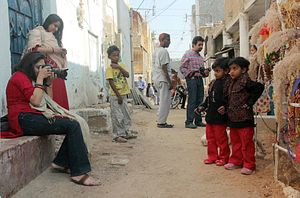Her love for her city is set in stone. Through her project, “Humans of Karachi” (an immensely popular Facebook page inspired by Brandon Stanton’s “Humans of New York” page), Karachi-based photographer Khaula Jamil provides her audience with a different, more humane side of Karachi.
Featuring Pakistanis from all walks of life, Jamil has emulated Stanton’s model by not only featuring the overlooked, but also by quoting her subjects about their lives, their hopes, and their dreams. The photographs and stories are as rich as they are varied. Honest, raw and intriguing, the page offers a positive and, at its best, realistic portrayal of one portion of the Pakistani populace.
Initiated in 2012, the photographer states that she was inspired to launch her page when Stanton encouraged others to launch similar pages as an ode to their cities. At the time, Jamil was working with the Citizens Archive of Pakistan – CAP, a non-profit co-founded by Pakistan’s Oscar-winning documentary filmmaker, Sharmeen Obaid-Chinoy.
“I emailed Sharmeen and said I really wanted to do this and perhaps we could make it a culture project that CAP supports. She loved the idea and gave me the go ahead to choose whose help I wanted and [to] start,” Jamil says, “CAP has been great with supporting this project.”
Given the rapid trend in photography and video-based social media apps and the media’s heavy reliance on visuals and less text for impact, can pages like Humans of Karachi be used as a tool to connect societies? “It’s really quite simple,” states Jamil, “We are living in a day and age where information is being shared so rapidly that the visual dialogue is taking over; especially in social media. Photojournalism is so vast that it puts a face to that story you once only heard of – once you see a face and connect the story to THAT person it somehow validates what is being said. It is simply a classic case of ‘seeing is believing.’”
However, given photography’s constant, unrelenting metamorphosis thanks to the advancements of technology, do apps like Instagram aid in shaping or destroying the art of photography?
“I think apps like Instagram are changing the course of photography for sure, in a two-fold manner,” Jamil answers, “Where apps like Instagram are adding to the artistic side of the matter, perhaps the one place they are harming the industry is the way they have begun to devalue the profession of photography. Photojournalists are getting paid less because amateurs and bad photographers are able to make mediocre photographs not look terrible thanks to these apps. Having said that, I believe trained photographers or those who have developed their art over several years (with practice and patience) will always stand out from the crowd. I personally love Instagram and think it’s a great tool for photographers/journalists to make quick essays instantly no matter where they are.”
Currently working on a “Humans of Karachi” book and her side business of silver jewelry that features her own photography of Karachi, Lahore and Islamabad, the Fulbright scholar states that her Humans of Karachi project has made her far more daring as a photographer when she’s in the field, story and subject hunting.
“I was never one to feel uncomfortable photographing in the city in the first place but I have become even bolder in the past two years,” she says. “Karachi is not the easiest city to do a photo project like this in. People normally do not trust anyone with a camera. They immediately think you are from the press and that they will be misrepresented with some false claims. A large part of society believes image-taking is against Islam and so they look down upon it. I remain friendly and so does my partner in the project (Kamran, popularly known as KB) and together we manage to gain people’s trust – we have figured out how to be friendly and not offend anyone we approach.”
Sonya Rehman is a journalist based in Lahore, Pakistan. She can be reached at: sonjarehman [at] gmail.com



































